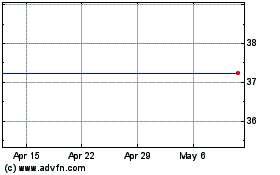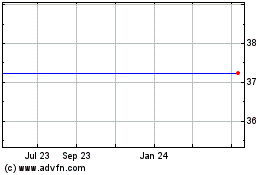Power Companies Await EPA Emissions Rule
December 16 2011 - 4:02PM
Dow Jones News
Power companies are watching closely as the Environmental
Protection Agency readies new limits on toxic pollution from power
plants in what could be one of the centerpieces of President Barack
Obama's environmental resume.
A flurry of lobbying from the industry came to a close Friday
with the arrival of a court deadline for the agency to act. The EPA
was expected to sign the rule Friday and officially announce the
details next week.
As proposed by the EPA this summer, the rule would impose strict
limits on mercury and other hazardous pollutants from power plants
that burn coal or oil to produce electricity, forcing older,
dirtier plants to install pollution controls or shut down
entirely.
Some companies may decide it is cheaper to close down a coal
plant then to install scrubbers or other controls. Exactly how many
plants will have to close as a result of the rule has been hotly
debated, but it is clear the rules will benefit companies that rely
more heavily on natural gas and nuclear generation, while imposing
costs on firms that have more coal plants that will need
retrofits.
Exelon Corp. (EXC), Constellation Energy Group Inc. (CEG), and
Public Service Enterprise Group Inc. (PEG) are among the companies
that have supported EPA's effort. American Electric Power Co. (AEP)
and Southern Co. (SO) have lobbied for more time to comply.
Unlike EPA limits on smog-forming ozone pollution, which the
administration delayed earlier this year, this rule has been
explicitly backed by Obama. His campaign website lists the proposed
standards among the president's environmental accomplishments,
saying they will "help to clear our skies of pollutants that can
make health problems like asthma and bronchitis worse."
When the EPA proposed the rule this summer, it said it would
avert more than 6,800 premature deaths per year, mostly because the
equipment installed to capture pollutants like mercury would also
catch tiny particles that are known to worsen heart and lung
problems. The agency also said the true benefits of the rule are
much larger than it can calculate. Mercury, for example, can impair
brain development in children, but it is difficult to quantify the
societal cost of a child with a lower IQ.
Some power companies, however, dispute EPA's analysis, which
puts the cost of the rule at about $10.9 billion per year, compared
to more than $59 billion in benefits. In particular, Southern,
American Electric Power and others have said the agency has not
given enough consideration to the consequences of closing or
retrofitting so many coal-fired power plants at once.
Organizations that oversee the electrical grids in Texas, the
Midwest, and New England have said if the EPA rules cause too many
plants go offline, they could cause blackouts. "What hangs in the
balance is the reliability of the electrical system," said Scott
Segal, director of the Electric Reliability Coordinating Council,
whose members include Southern and American Electric Power.
EPA insists the rules are achievable without threatening the
reliability of the grid. But it could appease industry by signaling
more flexibility on the timeline for complying with the rule.
The Edison Electric Institute, which represents the utility
industry, has asked EPA to give all plants that choose to install
retrofits at least four years to comply, and to make it clear that
plants needed for reliability can have five years to comply if
necessary.
But allowing more time to install pollution controls would irk
public health advocates, who have been conducting their own public
relations blitz in support of EPA.
"We are hoping for a strong rule," said Paul Billings, vice
president of national policy for the American Lung Association.
"Anything to delay the rules would be a problem."
So far, the EPA has said only that it will consider extensions
of the existing three-year timeline on a case-by-case basis.
-By Ryan Tracy, Dow Jones Newswires; 202-862-9245;
ryan.tracy@dowjones.com
Constellation Energy (NYSE:CEG)
Historical Stock Chart
From Mar 2024 to Apr 2024

Constellation Energy (NYSE:CEG)
Historical Stock Chart
From Apr 2023 to Apr 2024
